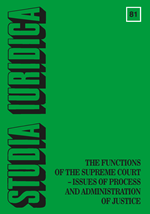Supreme Courts in the 21st Century: should organisation follow the function?
Supreme Courts in the 21st Century: should organisation follow the function?
Author(s): Alan UzelacSubject(s): Politics / Political Sciences, Law, Constitution, Jurisprudence, Public Administration
Published by: Wydawnictwa Uniwersytetu Warszawskiego
Keywords: Supreme Court; organisation of the Supreme Court; work efficiency in the Supreme Court; Sąd Najwyższy; organizacja Sądu Najwyższego; efektywność pracy w Sądzie Najwyższy
Summary/Abstract: The text discusses different aspects connected with organisation of supreme courts. It argues that the focus should be shifted to the “how” question. If the supreme courts aspire to fulfil certain special functions, a necessary precondition towards fulfilling this goal entails appropriate organisational structures, means and personnel. The organisation, framework and methods of work of a supreme court should reflect the functions that it is supposed to serve. Although most supreme courts have staff, departments and offices that are entrusted with legal research and analysis, the rise in importance of international jurisprudence is putting on the agenda the need for restructuring and reinforcing the existing departments. The author claims that supreme courts are becoming less and less self-centred in their adjudication, which requires legal research of international and comparative law. The text also deals with other aspects of supreme courts’ organisation. For instance, it shifts focus towards the relation between the number of judges in a supreme court and its impact on the uniformity of jurisprudence. It also emphasises the need to further examine the relation between the number of judges per capita and the efficiency of the court’s work.
Journal: Studia Iuridica
- Issue Year: 2019
- Issue No: 81
- Page Range: 125-139
- Page Count: 15
- Language: English

